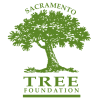What summers in Sacramento mean for our operations crew
by Loren O'Rourke
October 19, 2019
Even though we stop planting in the summer heat, our crew stays busy caring for all of the trees planted in previous seasons until they are three years old and can survive without further care or irrigation. With around 2,500 trees at 15 sites throughout the region, the reforestation team goes out in the field every day to make sure our saplings survive.
Watering is our primary concern when temperatures rise, as dry summers in Sacramento can be hard on trees and shrubs. Luckily, our team of reforestation technicians has watering trees down to a science. We take into account soil type, infiltration rates, temperature, and species when making irrigation decisions.

Chau and Brooke check drip emitters at the Bear River Habitat Trail to ensure our plants are effectively and accurately watered. SacTree’s staff use state-of-the art drip irrigation systems to make the most of this precious resource.
At our reforestation sites, we install exclusively native trees and plants that are well adapted to our low-rainfall summers. The coyote bush (Baccharis pilularis) pictured above is one of these plants that thrives in the Sacramento region. During the summer months, this hearty native is one of the only green plants in an otherwise brown landscape. This particular bush needs very little water, but supplemental watering can accelerate growth.
Over the duration of our projects, we slowly wean the trees and shrubs off watering. Eventually all of the plants we install will be able to thrive on their own without irrigation.
Wondering what these reforestation field days are like? Check out our events to find an upcoming volunteer opportunity where you can learn from these experts and help build a greener Sacramento!
